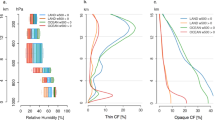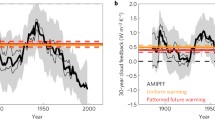Abstract
This research focuses on the observed tropical oceanic high clouds above the 300 hPa level, to investigate their diurnal cycles and radiative effects at the top of atmosphere. The diurnal centroid is used to quantify the diurnal cycle based on circular statistics to indicate the daily peaking time of cloud cover. It is found that the diurnal cycle of the tropical oceanic high clouds can significantly impact their cloud radiative effects, with a correlation coefficient of − 0.63 at the 95% significant level and a slope of − 14.5 Wm−2 h−1 between the net cloud radiative effects and the diurnal centroid shifting from midnight towards noon. This implies that the changes of the diurnal cycle can strongly influence the Earth radiative budget, and thus possibly impose radiative feedbacks to affect atmospheric circulations under global climate warming. It is also found that the strength of convection and the cold point temperature are two major environmental factors in influencing the diurnal-cycle centroid of the tropical oceanic high clouds. Furthermore, according to observations, the correlation coefficient between the diurnal-cycle centroid of the tropical oceanic high clouds and the global mean temperature is 0.75 at the 95% significant level, indicating a 2-h shift of the tropical oceanic high clouds towards noon with 1℃ increases of the global mean temperature.






Similar content being viewed by others
Data availability
In this study, the CERES SYN1degEd4.1 product can be found at https://ceres.larc.nasa.gov/data/. The ERA5 reanalysis data can be downloaded at https://cds.climate.copernicus.eu/cdsapp#!/home. The data of the global mean temperature are from the climate indices of the Physical Sciences Laboratory (PSL) at https://psl.noaa.gov/.
References
Bony S et al (2015) Clouds, circulation and climate sensitivity. Nat Geosci 8:261–268. https://doi.org/10.1038/ngeo2398
Boucher O et al. (2013) Clouds and aerosols. In: Climate change 2013: the physical science basis. Contribution of working group I to the fifth assessment report of the intergovernmental panel on climate change. Cambridge University Press, pp 571–657
Brewer AW (1949) Evidence for a world circulation provided by the measurements of helium and water vapour distribution in the stratosphere. Q J R Meteorol Soc 75:351–363. https://doi.org/10.1002/qj.49707532603
Ceppi P, Hartmann DL, Webb MJ (2016) Mechanisms of the negative shortwave cloud feedback in middle to high latitudes. J Clim 29:139–157. https://doi.org/10.1175/Jcli-D-15-0327.1
Ceppi P, Brient F, Zelinka MD, Hartmann DL (2017) Cloud feedback mechanisms and their representation in global climate models. Wiley Interdiscip Rev Clim Change. https://doi.org/10.1002/wcc.465
Chen G, Du Y, Wen Z (2021) Seasonal, interannual, and interdecadal variations of the East Asian summer monsoon: a diurnal-cycle perspective. J Clim 34:4403–4421. https://doi.org/10.1175/jcli-d-20-0882.1
Chepfer H, Brogniez H, Noel V (2019) Diurnal variations of cloud and relative humidity profiles across the tropics. Sci Rep 9:16045. https://doi.org/10.1038/s41598-019-52437-6
Clement AC, Soden B (2005) The sensitivity of the tropical-mean radiation budget. J Clim 18:3189–3203. https://doi.org/10.1175/jcli3456.1
Corti T, Luo BP, Fu Q, Vömel H, Peter T (2006) The impact of cirrus clouds on tropical troposphere-to-stratosphere transport. Atmos Chem Phys 6:2539–2547. https://doi.org/10.5194/acp-6-2539-2006
Dessler AE, Yang P (2003) The distribution of tropical thin cirrus clouds inferred from TerraMODIS data. J Clim 16:1241–1247. https://doi.org/10.1175/1520-0442(2003)16%3c1241:Tdottc%3e2.0.Co;2
Eastman R, Warren SG (2014) Diurnal cycles of cumulus, cumulonimbus, stratus, stratocumulus, and fog from surface observations over land and ocean. J Clim 27:2386–2404. https://doi.org/10.1175/jcli-d-13-00352.1
England MH et al (2014) Recent intensification of wind-driven circulation in the Pacific and the ongoing warming hiatus Nature. Clim Change 4:222–227. https://doi.org/10.1038/nclimate2106
Gasparini B, Blossey PN, Hartmann DL, Lin G, Fan J (2019) What drives the life cycle of tropical anvil clouds? J Adv Model Earth Syst 11:2586–2605. https://doi.org/10.1029/2019ms001736
Gasparini B, Sokol AB, Wall CJ, Hartmann DL, Blossey PN (2022) Diurnal differences in tropical maritime anvil cloud evolution. J Clim 35:1655–1677. https://doi.org/10.1175/jcli-d-21-0211.1
Gasparini B, Rasch PJ, Hartmann DL, Wall CJ, Dütsch M (2021) A lagrangian perspective on tropical anvil cloud lifecycle in present and future climate. J Geophys Res Atmos. https://doi.org/10.1029/2020jd033487
Ge J, Wang Z, Liu YY, Su J, Wang C, Dong ZX (2019) Linkages between mid-latitude cirrus cloud properties and large-scale meteorology at the SACOL site. Clim Dynam 53:5035–5046. https://doi.org/10.1007/s00382-019-04843-9
Ge J, Wang Z, Wang C, Yang X, Dong Z, Wang M (2021) Diurnal variations of global clouds observed from the CATS spaceborne lidar and their links to large-scale meteorological factors. Clim Dynam. https://doi.org/10.1007/s00382-021-05829-2
Gettelman A, Forster PMDF (2002) A climatology of the tropical tropopause layer. J Meteorol Soc Jpn 80:911–924. https://doi.org/10.2151/jmsj.80.911
Grise KM, Thompson DWJ, Birner T (2010) A global survey of static stability in the stratosphere and upper troposphere. J Clim 23:2275–2292. https://doi.org/10.1175/2009jcli3369.1
Hartmann DL, Berry SE (2017) The balanced radiative effect of tropical anvil clouds. J Geophys Res Atmos 122:5003–5020. https://doi.org/10.1002/2017jd026460
Hartmann DL, Ockert-Bell ME, Michelsen ML (1992) The effect of cloud type on earth’s energy balance: global analysis. J Clim 5:1281–1304. https://doi.org/10.1175/1520-0442(1992)005%3c1281:Teocto%3e2.0.Co;2
Hartmann DL, Larson K (2002) An important constraint on tropical cloud—climate feedback. Geophys Res Lett. https://doi.org/10.1029/2002gl015835
Hartmann DL, Holton JR, Fu Q (2001) The heat balance of the tropical tropopause, cirrus, and stratospheric dehydration. Geophys Res Lett 28:1969–1972. https://doi.org/10.1029/2000gl012833
Hersbach H et al (2020) The ERA5 global reanalysis. Q J R Meteorol Soc 146:1999–2049. https://doi.org/10.1002/qj.3803
Kosaka Y, Xie SP (2013) Recent global-warming hiatus tied to equatorial Pacific surface cooling. Nature 501:403–407. https://doi.org/10.1038/nature12534
Kubar TL, Hartmann DL, Wood R (2007) Radiative and convective driving of tropical high clouds. J Clim 20:5510–5526. https://doi.org/10.1175/2007jcli1628.1
Lee J, Yang P, Dessler AE, Gao B-C, Platnick S (2009) Distribution and radiative forcing of tropical thin cirrus clouds. J Atmos Sci 66:3721–3731. https://doi.org/10.1175/2009jas3183.1
Letu H et al (2019) Ice cloud properties from himawari-8/AHI next-generation geostationary satellite: capability of the AHI to monitor the DC cloud generation process. IEEE Trans Geosci Remote Sens 57:3229–3239. https://doi.org/10.1109/tgrs.2018.2882803
Letu H et al (2021) A new benchmark for surface radiation products over the East Asia-Pacific region retrieved from the Himawari-8/AHI next-generation geostationary satellite. Bull Am Meteorol Soc. https://doi.org/10.1175/bams-d-20-0148.1
Li J et al (2011) Radiative effect differences between multi-layered and single-layer clouds derived from CERES CALIPSO, and CloudSat data. J Quant Spectrosc Radiat Transfer 112:361–375. https://doi.org/10.1016/j.jqsrt.2010.10.006
Li Y, Thompson DWJ, Stephens GL, Bony S (2014) A global survey of the instantaneous linkages between cloud vertical structure and large-scale climate. J Geophys Res Atmos 119:3770–3792. https://doi.org/10.1002/2013jd020669
Li Y, Ge J, Dong Z, Hu X, Yang X, Wang M, Han Z (2020) Pairwise-rotated EOFs of global cloud cover and their linkages to sea surface temperature. Int J Climatol 41:2342–2359. https://doi.org/10.1002/joc.6962
Lilly DK (1988) Cirrus outflow dynamics. J Atmos Sci 45:1594–1605. https://doi.org/10.1175/1520-0469(1988)045%3c1594:Cod%3e2.0.Co;2
Lindzen RS, Chou M-D, Hou AY (2001) Does the earth have an adaptive infrared iris? Bull Am Meteor Soc 82:417–432. https://doi.org/10.1175/1520-0477(2001)082%3c0417:Dtehaa%3e2.3.Co;2
Martin RV, Folkins I (2005) The vertical structure of tropical convection and its impact on the budgets of water vapor and ozone. J Atmos Sci 62:1560–1573. https://doi.org/10.1175/jas3407.1
Mauritsen T, Stevens B (2015) Missing iris effect as a possible cause of muted hydrological change and high climate sensitivity in models. Nat Geosci 8:346–351. https://doi.org/10.1038/ngeo2414
McPhaden MJ (2004) Pacific ocean circulation rebounds. Geophys Res Lett. https://doi.org/10.1029/2004gl020727
Minnis P et al (2008) Cloud detection in nonpolar regions for CERES using TRMM VIRS and terra and aqua MODIS data. IEEE Trans Geosci Remote Sens 46:3857–3884. https://doi.org/10.1109/tgrs.2008.2001351
Minnis P et al (2011) CERES edition-2 cloud property retrievals using TRMM VIRS and terra and aqua MODIS data—part I: algorithms. IEEE Trans Geosci Remote Sens 49:4374–4400. https://doi.org/10.1109/tgrs.2011.2144601
Noel V, Chepfer H, Chiriaco M, Yorks J (2018) The diurnal cycle of cloud profiles over land and ocean between 51°S and 51°N, seen by the CATS spaceborne lidar from the International Space Station. Atmos Chem Phys 18:9457–9473. https://doi.org/10.5194/acp-18-9457-2018
Norris JR, Allen RJ, Evan AT, Zelinka MD, O’Dell CW, Klein SA (2016) Evidence for climate change in the satellite cloud record. Nature 536:72–75. https://doi.org/10.1038/nature18273
Powell SW, Houze RA, Kumar A, McFarlane SA (2012) Comparison of simulated and observed continental tropical anvil clouds and their radiative heating profiles. J Atmos Sci 69:2662–2681. https://doi.org/10.1175/jas-d-11-0251.1
Randel WJ, Jensen EJ (2013) Physical processes in the tropical tropopause layer and their roles in a changing climate. Nat Geosci 6:169–176. https://doi.org/10.1038/ngeo1733
Rao JS, Sengupta A (2001) Topics in circular statistics. World scientific
Ruppert JH, Klocke D (2019) The two diurnal modes of tropical upward motion. Geophys Res Lett 46:2911–2921. https://doi.org/10.1029/2018gl081806
Sassen K, Wang Z, Liu D (2008) Global distribution of cirrus clouds from CloudSat/Cloud-Aerosol Lidar and Infrared Pathfinder Satellite Observations (CALIPSO) measurements. J Geophys Res. https://doi.org/10.1029/2008jd009972
Shang H et al (2018) Diurnal cycle and seasonal variation of cloud cover over the Tibetan Plateau as determined from Himawari-8 new-generation geostationary satellite data. Sci Rep 8:1105. https://doi.org/10.1038/s41598-018-19431-w
Sherwood SC et al (2020) An assessment of earth’s climate sensitivity using multiple lines of evidence. Rev Geophys 58:e2019RG000678. https://doi.org/10.1029/2019RG000678
Soden BJ (2000) The diurnal cycle of convection, clouds, and water vapor in the tropical upper troposphere. Geophys Res Lett 27:2173–2176. https://doi.org/10.1029/2000gl011436
Tian B (2004) Diurnal cycle of convection, clouds, and water vapor in the tropical upper troposphere: satellites versus a general circulation model. J Geophys Res. https://doi.org/10.1029/2003jd004117
Trepte QZ et al (2019) Global cloud detection for CERES edition 4 using terra and aqua MODIS data. IEEE Trans Geosci Remote Sens 57:9410–9449. https://doi.org/10.1109/tgrs.2019.2926620
Tseng H-H, Fu Q (2017) Temperature control of the variability of tropical tropopause layer cirrus clouds. J Geophys Res Atmos 122:11062–11075. https://doi.org/10.1002/2017jd027093
Wall CJ, Norris JR, Gasparini B, Smith WL, Thieman MM, Sourdeval O (2020) Observational evidence that radiative heating modifies the life cycle of tropical anvil clouds. J Clim 33:8621–8640. https://doi.org/10.1175/Jcli-D-20-0204.1
Wang H, Burleyson CD, Ma P-L, Fast JD, Rasch PJ (2018) Using the atmospheric radiation measurement (ARM) datasets to evaluate climate models in simulating diurnal and seasonal variations of tropical clouds. J Clim 31:3301–3325. https://doi.org/10.1175/jcli-d-17-0362.1
Webb MJ et al (2014) The Diurnal cycle of marine cloud feedback in climate models. Clim Dynam 44:1419–1436. https://doi.org/10.1007/s00382-014-2234-1
Webster PJ, Clayson CA, Curry JA (1996) Clouds, radiation, and the diurnal cycle of sea surface temperature in the tropical Western Pacific. J Clim 9:1712–1730. https://doi.org/10.1175/1520-0442(1996)009%3c1712:Cratdc%3e2.0.Co;2
Wu L, Su H, Jiang JH, Read WG (2012) Hydration or dehydration: competing effects of upper tropospheric cloud radiation on the TTL water vapor. Atmos Chem Phys 12:7727–7735. https://doi.org/10.5194/acp-12-7727-2012
Wu Q, Hong J, Ruan Z (2020) Diurnal variations in tropical cyclone intensification. Geophys Res Lett. https://doi.org/10.1029/2020gl090397
Yang G-Y, Slingo J (2001) The diurnal cycle in the tropics. Mon Weather Rev 129:784–801. https://doi.org/10.1175/1520-0493(2001)129%3c0784:Tdcitt%3e2.0.Co;2
Yin J, Porporato A (2017) Diurnal cloud cycle biases in climate models. Nat Commun 8:2269. https://doi.org/10.1038/s41467-017-02369-4
Yin J, Porporato A (2019) Radiative effects of daily cycle of cloud frequency in past and future climates. Clim Dynam 54:1625–1637. https://doi.org/10.1007/s00382-019-05077-5
Zelinka MD, Hartmann DL (2010) Why is longwave cloud feedback positive? J Geophys Res. https://doi.org/10.1029/2010jd013817
Zhao W, Marchand R, Fu Q (2017) The diurnal cycle of clouds and precipitation at the ARM SGP site: cloud radar observations and simulations from the multiscale modeling framework. J Geophys Res Atmos 122:7519–7536. https://doi.org/10.1002/2016jd026353
Funding
This work was supported by the National Science Foundation of China (41922032, 41875028 and 41575016).
Author information
Authors and Affiliations
Corresponding author
Ethics declarations
Conflict of interest
The authors declare no conficts of interest or competing interests.
Additional information
Publisher's Note
Springer Nature remains neutral with regard to jurisdictional claims in published maps and institutional affiliations.
Rights and permissions
About this article
Cite this article
Wang, Z., Ge, J., Yan, J. et al. Interannual shift of tropical high cloud diurnal cycle under global warming. Clim Dyn 59, 3391–3400 (2022). https://doi.org/10.1007/s00382-022-06273-6
Received:
Accepted:
Published:
Issue Date:
DOI: https://doi.org/10.1007/s00382-022-06273-6




